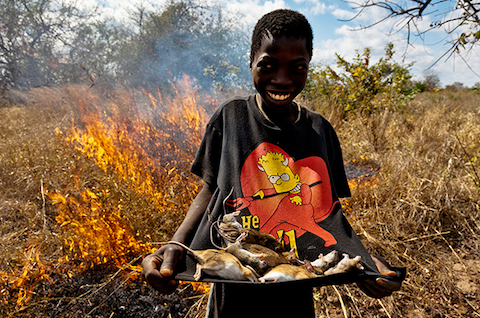
Microkhan Jr. has reached the age at which he’s starting to ask about food taboos—like, why we eat pigs but not horses (a recent dinnertime inquiry). In straining to explain the nuances of societal dietary preferences, I thought of this incredible photo essay on the rat catchers of Mozambique, who provide that nation’s blue-collar workers with an affordable source of meat—albeit one that many Americans might find icky. Yet Mozambique’s appetite for this protein source is such that the rodent harvest is causing serious environmental damage:
Albinio Matias, a Mozambican farmer, lost his daughter, Cassula, and his home to wildfires, which also damaged his crops for four consecutive years. “The fires were set by youngsters hunting for rats, and because our houses were close to the weeds they caught fire and I lost everything,” said Matias, who lives in the Macossa district of Manica Province in central Mozambique. Hunters would start fires to flush out rodents from the forests and the bush to eat, and the blaze would often get out of hand.
Around 70 percent of Mozambique’s 20 million people live in rural areas where every year thousands are displaced or lose their possessions, homes and crops to these fires. Manica Province’s Forest and Wildlife Services said 43 wildfires were caused by rat hunters in 2007; in 2008 that figure rose to 60 and led to 15 deaths and the displacement of 200 families.
This is definitely an instance in which controlled production is far preferable to the “free-range” approach. But while our species has proven quite adept at wiping out rat populations, we’ve had a much harder time breeding them for meat—at least not profitably. Some reasons why can be found here; suffice to say that rats aren’t quite as compliant as, say, chickens when it comes to determining gender and organizing efficient breeding schedules.
Also, as detailed here, rats are actually quite sensitive to environmental toxins such as pesticides. That detail surprised me: You’d think any animal capable of thriving off congealed grease in the sewers of Washington D.C. would let a little aldicarb slide right off their backs.
The photographer behind the rat-catching series, Vlad Sokhin, is a gem, by the way; check out more of his work here.


capturedshadow // Apr 16, 2012 at 12:58 pm
Amazing photo.
I had a girlfriend from mainland China years ago, whom had no food taboos of which I was aware. Not that she liked everything, but I don’t think there were any moral objections to anything edible. Cats, bugs, grubs whatever-as long as they were tasty…..
Jordan // Apr 16, 2012 at 3:38 pm
Sounds like an argument for rabbit farming.
Brendan I. Koerner // Apr 16, 2012 at 8:38 pm
@capturedshadow: I definitely respect the consistent logic of that gustatory stance. When you get right down to it, most food taboos are pretty arbitrary. In a blind taste test, I’m sure I would have no problem with, say, cane-rat meat.
Brendan I. Koerner // Apr 16, 2012 at 8:39 pm
@Jordan: Seems like rabbits should be a bigger livestock commodity than they are. I wonder if there just isn’t enough yield per animal to make the endeavor worthwhile for all but specialty producers.
Jordan // Apr 16, 2012 at 9:48 pm
@Brendan: rabbits actually seem to be a rather good food animal, it’s just that we don’t hear much about it in the U.S. given the fairly common American aversion to eating rabbits (they’re usually pets, the Bambi Effect). International development orgs like Heifer will try to set up rabbit farms in appropriate areas because they breed and develop so quickly. I think there are also specialized breeds that have been developed to maximize yield.
Here’s a 2007 report I found: http://www.lrrd.org/lrrd19/9/luke19138.htm